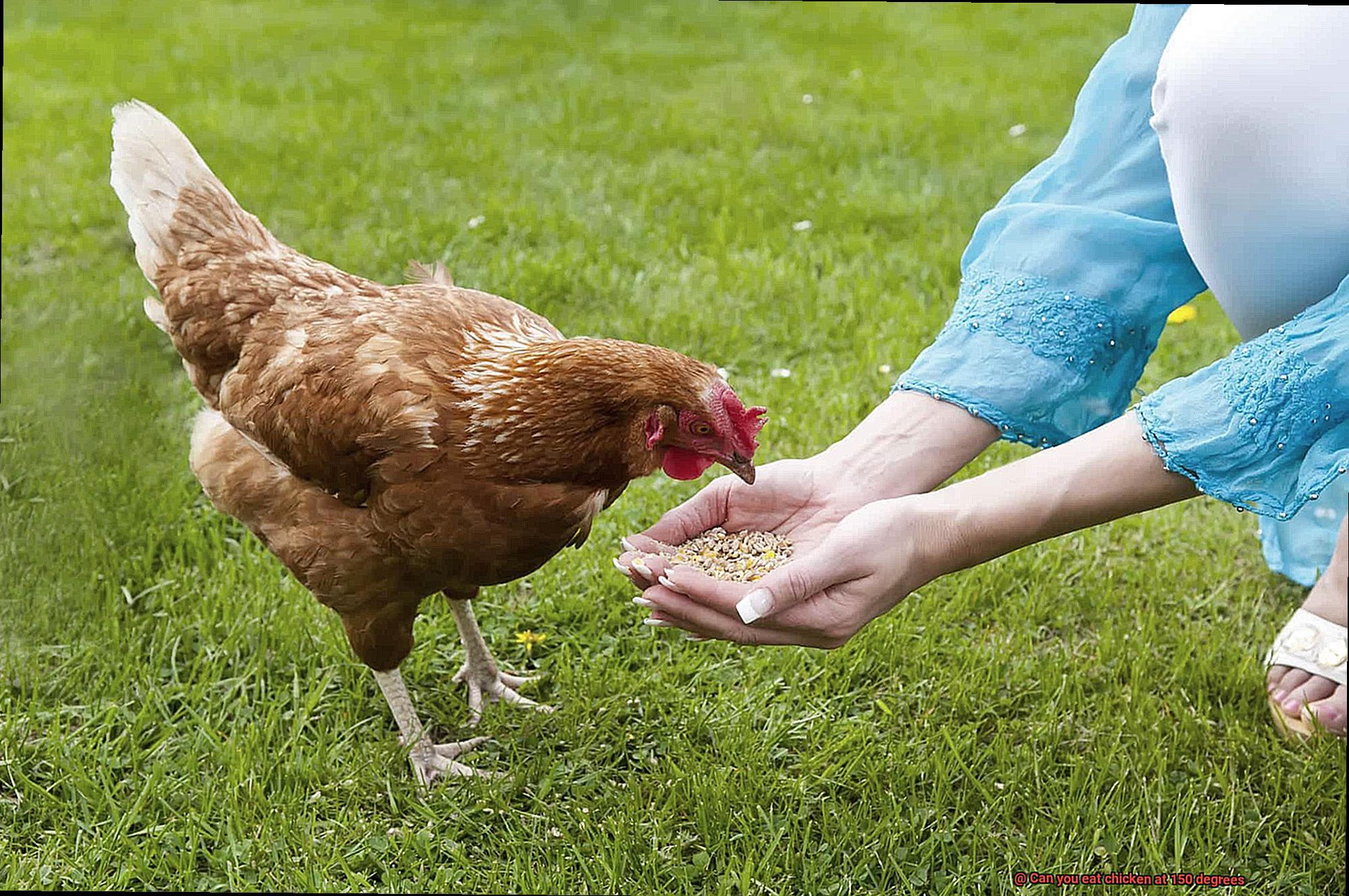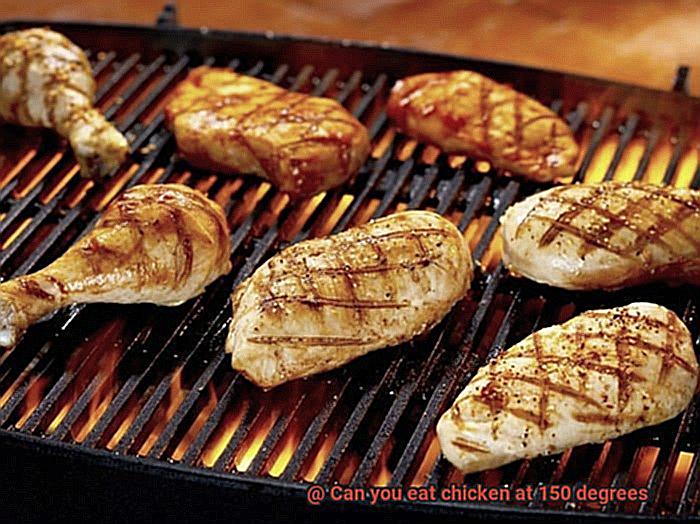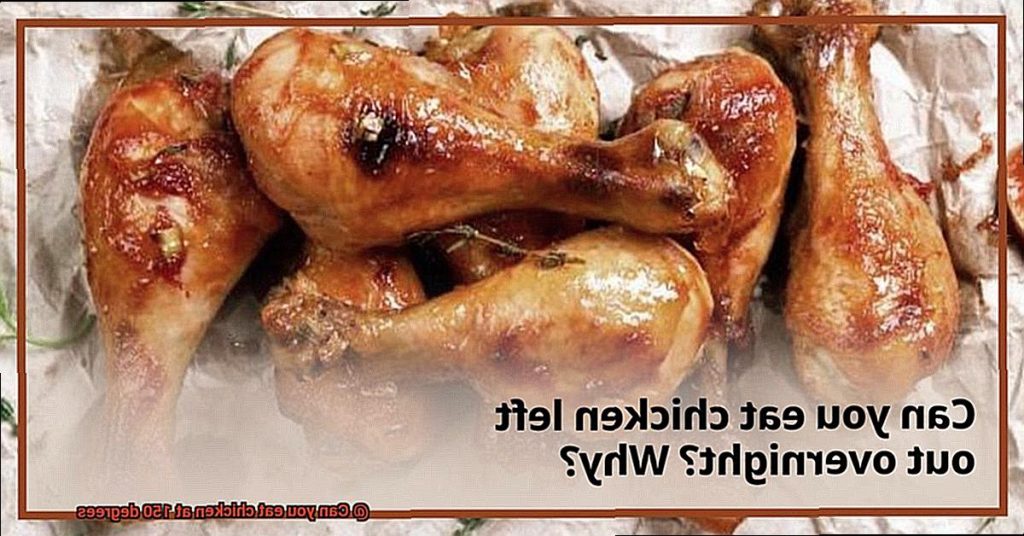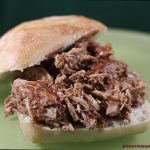Food safety is like walking a tightrope, especially when it comes to poultry. We’ve all wondered, “Can you eat chicken at 150 degrees?” It’s a burning question that ignites our taste buds and our worries about getting sick. Today, we’re diving into the fiery world of meat temperatures to debunk myths, set the record straight, and make sure your next chicken feast is both finger-licking good and safe as can be.
Join us as we embark on a deep dive into this age-old culinary conundrum. We’ll unravel the science behind cooking temps, uncover bacterial risks lurking in undercooked chicken, and dish out the recommended guidelines from food safety authorities. By the end of this article, you’ll have all the juicy details on whether 150 degrees Fahrenheit can truly deliver a mouthwatering meal without any health hazards.
So, grab your apron and let’s get cooking. Together, we’ll uncover the sizzling truth about eating chicken at 150 degrees—because no one wants their dinner to leave them feeling roasted.
Contents
What is the US Department of Agriculture’s Recommended Internal Temperature for Chicken?
Cooking chicken to the proper internal temperature is crucial for ensuring food safety. The US Department of Agriculture (USDA) has established guidelines to help consumers prepare chicken safely. In this article, we will explore the USDA’s recommended internal temperature for chicken and its importance in preventing foodborne illnesses.
The USDA’s Recommended Internal Temperature:
According to the USDA, chicken should be cooked to a minimum internal temperature of 165°F (74°C). This temperature ensures that harmful bacteria, such as Salmonella and Campylobacter, are destroyed, making the chicken safe to consume. It is important to measure the internal temperature in the thickest part of the chicken, avoiding contact with bones or gristle, to ensure accuracy.
Food Safety Considerations:

The USDA’s recommended internal temperature of 165°F is based on extensive research and scientific evidence. Cooking chicken to this temperature effectively kills bacteria and reduces the risk of foodborne illnesses. Consuming undercooked chicken can lead to severe gastrointestinal issues and other health complications.
Alternative Cooking Methods and Lower Temperatures:
While the USDA’s recommendation is widely accepted, there has been some debate about lower cooking temperatures for chicken. Some chefs and food experts argue that chicken can be safely consumed at 150°F (66°C), as long as specific conditions are met. For example, cooking chicken sous vide at this lower temperature for a longer duration can effectively destroy bacteria. However, it is important to note that these methods may require additional safeguards and precautions.
Personal Preference vs. Safety:
It is understandable that individuals may have preferences for different levels of doneness or juiciness when cooking chicken. However, ensuring food safety should always take precedence. By following the USDA’s recommended internal temperature of 165°F, you can achieve both safety and an enjoyable dining experience. Resting the cooked chicken for a few minutes after reaching the target temperature allows the juices to redistribute, resulting in a flavorful and tender chicken.
Is Cooking Chicken to 150 Degrees Fahrenheit Safe?
When it comes to grilling chicken, there’s always a debate about the perfect temperature. While food safety experts recommend cooking chicken to an internal temperature of 165 degrees Fahrenheit, some argue that cooking it to a slightly lower temperature, such as 150 degrees, can still be safe and result in juicier and more tender meat.
The United States Department of Agriculture (USDA) states that poultry should be cooked to a minimum internal temperature of 165 degrees Fahrenheit for safety reasons. This is because bacteria like salmonella are killed almost instantly at this temperature. However, the USDA also acknowledges that some consumers prefer their poultry cooked to lower temperatures for taste and texture reasons.
To address this demand, the USDA provides an alternative guideline known as the “cook to temperature plus hold” method. According to this method, if chicken is cooked to a temperature slightly below 165 degrees Fahrenheit (such as 150 degrees), it must then be held at that temperature for at least 3 minutes to ensure any bacteria are destroyed.
It’s important to note that this “cook to temperature plus hold” method should only be used for whole cuts of chicken, such as breasts or thighs. Ground chicken or poultry products containing ground chicken should always be cooked to 165 degrees Fahrenheit due to the increased risk of bacterial contamination.
Another factor to consider when deciding on the cooking temperature is the quality and sourcing of the chicken. If you are confident in the quality and handling practices of the chicken you are using, cooking it to a slightly lower temperature may be deemed safer.
Ultimately, the decision of whether to cook chicken to 150 degrees Fahrenheit or to the recommended 165 degrees Fahrenheit should be based on personal preference and risk tolerance. It’s important to weigh the potential benefits of juicier meat against the small but existing risk of foodborne illness.
Regardless of the chosen temperature, it’s crucial to handle and store raw chicken properly, ensuring it is kept at a safe temperature and not cross-contaminated with other foods, to further minimize the risk of bacterial contamination.
Benefits of Cooking Chicken at Lower Temperatures

Grilling chicken is an art that requires finesse and precision. But what if we told you there’s a secret technique that can elevate your grilled chicken game? It’s all about cooking the chicken at lower temperatures. In this blog post, we’ll dive into the juicy benefits of this method and why it’s worth giving it a try. So grab your apron and get ready to become a grilling maestro.
Retaining Moisture:
Imagine taking a bite into perfectly grilled chicken that practically melts in your mouth. The secret behind this tantalizing tenderness lies in cooking the chicken at lower temperatures. When cooked on high heat, muscle fibers contract rapidly, forcing out precious juices and leaving you with a dry and tough texture. However, by opting for lower temperatures, these muscle fibers have more time to relax, resulting in moist and succulent meat that will make your taste buds dance with delight.
Even Cooking:

There’s nothing worse than biting into a beautifully charred piece of chicken only to find it undercooked in the middle. Not only is this disappointing, but it also poses a risk to your health. By cooking chicken at lower temperatures, you ensure that heat penetrates evenly throughout the meat. Say goodbye to undercooked centers and hello to perfectly cooked chicken that is both safe to eat and oh-so-tender.
Enhanced Flavor:
Grilling chicken at lower temperatures is like slow dancing with flavor. High heat cooking can sometimes overpower the natural taste of chicken, leaving you with a charred or burnt aftertaste. Lower temperature cooking allows for a more delicate and nuanced flavor profile. As the chicken cooks slowly, its natural flavors have ample time to develop, resulting in a symphony of deliciousness that will leave you craving more.
Avoiding Overcooking:
We’ve all been there – one minute your chicken is perfectly cooked, and the next, it’s dry and rubbery. Lower temperature grilling minimizes the risk of overcooking. With this method, you have a more forgiving cooking environment that allows you to achieve that sweet spot of tender perfection without fear of turning your chicken into an inedible disappointment.
Energy Efficiency:
Let’s not forget about the practical side of cooking chicken at lower temperatures – it’s energy-efficient. Lower temperature cooking requires less energy to maintain compared to high heat methods. This means savings on your electricity or gas bills, which is always a win in our books. So not only are you treating yourself to a mouthwatering meal, but you’re also being kind to your wallet and the environment.
Potential Risks Associated with Eating Chicken Cooked at Lower Temperatures
As we embark on our cooking adventures, it’s crucial to understand the potential risks associated with eating chicken cooked at lower temperatures. In this article, we will delve into the dangers that lurk beneath the surface of undercooked chicken and why prioritizing food safety is essential. So, get ready to safeguard your taste buds and master the art of cooking chicken to perfection.
The Battle Against Bacteria:
Cooking chicken at lower temperatures poses a significant concern – the survival of harmful bacteria like Salmonella and Campylobacter. These elusive microorganisms thrive in raw poultry and can wreak havoc on our digestive systems if ingested. Imagine enduring an unpleasant symphony of vomiting, diarrhea, abdominal cramps, and fever – not exactly the dining experience you had in mind.

The Magic Number – 165°F:
To ensure food safety, it is crucial to achieve an internal temperature of 165 degrees Fahrenheit when cooking chicken. At this magical threshold, harmful bacteria are efficiently exterminated, rendering your grilled chicken safe to consume. Unfortunately, when chicken is cooked at lower temperatures, it may not reach this critical temperature throughout the meat, leaving certain parts undercooked and potentially hazardous.
Undercooked Chicken: A Safety Concern and Culinary Catastrophe:
Beyond the safety risks involved, undercooked chicken can turn your culinary masterpiece into a nightmare. No one wants to sink their teeth into rubbery meat that ruins their grilling triumph. So, even if you prefer a slightly lower cooking temperature for tenderness or personal taste preferences, it’s important to remember that it comes with an increased risk of foodborne illness.
Vulnerable Individuals Beware:
While everyone should prioritize food safety, certain individuals with weakened immune systems are particularly susceptible to foodborne illnesses. Young children, pregnant women, older adults, and those with underlying health conditions must exercise extra caution. If you fall into any of these categories, it is best to avoid consuming chicken that hasn’t been cooked to the recommended internal temperature.
How to Ensure Safety When Cooking Chicken at Lower Temperatures
Cooking chicken at lower temperatures can be a delicious and tender way to prepare a meal, but it is essential to prioritize safety to avoid any risk of foodborne illnesses. By following these guidelines, you can ensure that your chicken is cooked to perfection while keeping yourself and your loved ones healthy and happy.
Quality Matters
Begin with fresh, high-quality chicken that has been properly stored and refrigerated until you are ready to cook. This will minimize the presence of any unwanted bacteria that could cause illness.
Marinade Magic
Marinating your chicken not only adds flavor but can also help tenderize the meat. Think of it as giving your chicken a rejuvenating spa treatment. Opt for acidic marinades, like those containing vinegar or citrus juice, as they can even help kill bacteria on the surface of the chicken.
Temperature Check
When cooking at lower temperatures, it is crucial to use a food thermometer to ensure that your chicken reaches a safe internal temperature. Insert the thermometer into the thickest part of the chicken without touching bone or fat. Aim for at least 150 degrees Fahrenheit (65 degrees Celsius) and allow the chicken to rest for a few minutes before serving.
Know the Risks
Cooking chicken at lower temperatures carries a higher risk of bacterial contamination because the bacteria may not be completely killed off. Only attempt cooking at lower temperatures if you are confident in your cooking skills and have access to high-quality ingredients.
Clean and Careful
Practicing good hygiene is always a must. Wash your hands thoroughly before and after handling raw chicken, use separate cutting boards and utensils for raw and cooked chicken, and clean everything with hot soapy water after use. Leave no room for germs.
Remember, if you are unsure about cooking chicken at lower temperatures or have concerns about safety, it is best to err on the side of caution and cook your chicken to the recommended internal temperature of 165 degrees Fahrenheit (75 degrees Celsius). It is always better to be safe than sorry.
Different Methods for Cooking Chicken at Lower Temperatures
Cooking chicken at lower temperatures allows for a more tender and flavorful result. There are several methods that can be used to achieve this, each with its own unique benefits.
Firstly, indirect grilling involves setting up the grill so that the heat source is not directly under the chicken. By placing the chicken on a cooler part of the grill and closing the lid, a slow and even cooking environment is created. This method is ideal for larger pieces of chicken, such as whole chickens or chicken thighs.
Smoking is another method that can be used to cook chicken at lower temperatures on the grill. By adding wood chips or chunks to the grill, smoke is created that imparts a delicious smoky flavor to the chicken. The temperature inside the grill should be kept low, around 225°F (107°C), and the chicken should be cooked slowly over a longer period of time. Smoking is perfect for those who love that authentic barbecue taste.
Grilling with a foil packet is a great option for those who prefer quicker cooking times but still want to cook at lower temperatures. Simply wrap seasoned chicken in aluminum foil and place it on the grill. The foil packet helps to retain moisture and allows for gentle cooking at lower temperatures. This method works well for smaller pieces of chicken, such as chicken breasts or kebabs.
Beer can chicken is a fun and flavorful way to cook chicken at lower temperatures on the grill. This involves placing a partially filled beer can in the cavity of a whole chicken and standing it upright on the grill. As the chicken cooks, the beer steams from the inside, resulting in a moist and tender chicken. The grill should be set to a low temperature, around 300°F (149°C), and the chicken should be cooked slowly over indirect heat.
In addition to grilling methods, there are other ways to cook chicken at lower temperatures. Slow cooking in a crockpot or slow cooker allows for a longer cooking time at a lower temperature, resulting in tender and juicy chicken. Sous vide cooking involves vacuum-sealing the chicken and cooking it in a water bath at a precise temperature, producing perfectly cooked and tender meat. Poaching the chicken in liquid, such as broth or water, also yields tender and flavorful results. Finally, oven roasting at a lower temperature can achieve juicy and flavorful chicken.
Who Should Exercise Extra Caution When Eating Undercooked Chicken?
When it comes to grilling, sinking your teeth into a perfectly cooked piece of chicken can be an unbeatable pleasure. However, undercooked chicken can harbor harmful bacteria that pose serious health risks. In this article, we will explore who should exercise extra caution when eating undercooked chicken and why.
Pregnant Women:
During pregnancy, women’s immune systems naturally weaken, making them more susceptible to infections. Undercooked chicken presents a risk not only to the mother but also to the unborn baby, potentially leading to complications like miscarriage, premature birth, or stillbirth.

Young Children:
Young children have developing immune systems, leaving them vulnerable to foodborne illnesses. Additionally, they may struggle to communicate their discomfort or symptoms clearly. Caregivers should ensure that chicken is thoroughly cooked before serving it to young children to prevent potential health risks.

Older Adults:
As we age, our immune systems may weaken, making older adults more susceptible to infections. Older adults may also have underlying health conditions that further compromise their ability to fight off foodborne pathogens. To protect themselves, older adults should exercise caution and ensure that their chicken is properly cooked.
Individuals with Weakened Immune Systems:
Those with weakened immune systems, such as HIV/AIDS patients, individuals undergoing cancer chemotherapy, or those who have had organ transplants and are on immunosuppressant medications, face a higher risk of developing severe infections from undercooked chicken. It is advisable for these individuals to avoid consuming undercooked or raw chicken altogether.
Individuals with Gastrointestinal Disorders:
Certain gastrointestinal disorders can make individuals more susceptible to foodborne illnesses. Conditions like inflammatory bowel disease (IBD) or irritable bowel syndrome (IBS) can affect digestion and nutrient absorption, making it even more important for individuals with these disorders to ensure their chicken is fully cooked.
q3VTIkW4f7o” >
Conclusion
In conclusion, the question of whether you can eat chicken at 150 degrees is not a simple yes or no. While the USDA advises cooking chicken to an internal temperature of 165°F (74°C) for safety reasons, there are arguments in favor of slightly lower temperatures like 150°F (66°C) for juicier and more tender meat.
However, it’s crucial to understand the potential risks associated with cooking chicken at lower temperatures. Insufficiently cooked chicken may not reach the necessary temperature throughout to eliminate harmful bacteria such as Salmonella and Campylobacter, which can lead to foodborne illnesses. This is particularly concerning for vulnerable individuals like pregnant women, young children, older adults, those with weakened immune systems, and people with gastrointestinal disorders.
If you do opt for lower cooking temperatures, there are precautions you should take to minimize the risk of foodborne illness. Start by using high-quality chicken that has been stored and refrigerated correctly. Employ acidic marinades or other techniques to help kill surface bacteria on the chicken. Use a reliable food thermometer to ensure that the internal temperature reaches at least 150°F (65°C), and allow the chicken to rest before serving.
Above all else, prioritizing food safety should be your primary concern when preparing chicken. Handle and store raw chicken properly, avoiding cross-contamination with other foods.






